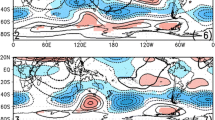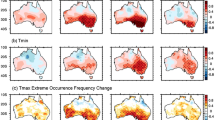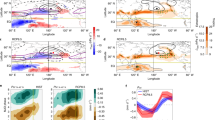Abstract
As a potential source of multiweek predictability, we investigate impacts of the Madden–Julian Oscillation (MJO) on temperature extremes during Austral winter using observational data analysis. We find a significant MJO influence on weekly mean minimum temperatures across much of northern and eastern Australia, with lower than normal minimum temperatures tending to occur during MJO phases 6 and 7. The likelihood of extreme weekly mean minimum temperatures also increases by at least of factor of 2 during these phases. In contrast, negligible impacts on maximum temperatures are observed. The proximate cause of the lower than normal minimum temperatures in these MJO phases is the anomalous equatorward advection of cool/dry continental air and enhanced night-time radiative cooling due to the drier conditions. The lack of any impact on maximum temperatures presumably stems from compensating day time warming from enhanced incoming shortwave radiation. The circulation anomalies over Australia during MJO phases 5–7 are shown to be a combination of the direct baroclinic response to the anomalous tropical convection driven by the MJO and the Rossby wave train that propagates from the tropics to the extratropics that is primarily confined to the Australian sector. The confinement of the extratropical Rossby wave train to the Australian sector results from a combination of localization of the Rossby wave source to the north of Australia and localization of wave propagation stemming from the refractive characteristics of the mean state zonal wind, which does not support tropical-extratropical wave paths to the east of Australia. An extratropical wave source due to feedback from transient eddies acts as an effective source of the extratropical response to the south of Australia and for the wave train that impinges on South America.





source advection term S1 (contoured, negative values dashed, zero contour omitted, interval 1.5 × 10–11 m2s−1). In Southern Hemisphere, positive Rossby wave source means anticyclonic tendency; an anticyclonic anomaly corresponds to negative streamfunction anomaly. Corresponding figures for MJO phase 1 to 4 are identically opposite in sign

source stretching term S2. For clarity contour interval 3 × 10–11 m2s−1 is used for S2 which is twice that for term S1 used in Fig. 5

source vortex stretching term S2 (contoured, negative values dashed, zero contour omitted, interval 3 × 10−11 m2s−1)



Similar content being viewed by others
References
Adames ÁF, Wallace JM (2014) Three-dimensional structure and evolution of the MJO and its relation to the mean flow. J Atmos Sci 71:2007–2026. https://doi.org/10.1175/JAS-D-13-0254.1
Alvarez MS, Vera CS, Kiladis GN, Liebmann B (2016) Influence of the Madden Julian Oscillation on precipitation and surface air temperature in South America. Clim Dyn 46:245–262. https://doi.org/10.1007/s00382-015-2581-6
Becker EJ, Berbery EH, Higgins RW (2011) Modulation of Cold-Season U.S. daily precipitation by the Madden–Julian Oscillation. J Clim 24:5157–5166. https://doi.org/10.1175/2011JCLI4018.1
Bretherton CS, Widmann M, Dymnikov VP et al (1999) The effective number of spatial degrees of freedom of a time-varying field. J Clim 12:1990–2009. https://doi.org/10.1175/1520-0442(1999)012<1990:TENOSD>2.0.CO;2
Dee DP, Uppala SM, Simmons AJ et al (2011) The ERA-Interim reanalysis: configuration and performance of the data assimilation system. Q J R Meteorol Soc 137:553–597. https://doi.org/10.1002/qj.828
Donald A, Meinke H, Power B et al (2006) Near-global impact of the Madden-Julian Oscillation on rainfall. Geophys Res Lett 33:L09704. https://doi.org/10.1029/2005GL025155
Freitas ACV, Ambrizzi T (2012) Changes in the Austral winter hadley circulation and the impact on stationary Rossby Waves propagation. Adv Meteorol 2012:15. https://doi.org/10.1155/2012/980816
Hendon HH, Salby ML (1994) The life cycle of the Madden–Julian Oscillation. J Atmos Sci 51:2225–2237
Holton JR (2004) An introduction to dynamic meteorology. Elsevier Academic Press, Amsterdam
Hoskins BJ, Ambrizzi T (1993) Rossby wave propagation on a realistic longitudinally varying flow. J Atmos Sci 50:1661–1671. https://doi.org/10.1175/1520-0469(1993)050<1661:RWPOAR>2.0.CO;2
Hoskins BJ, Karoly DJ (1981) The steady linear response of a spherical atmosphere to thermal and orographic forcing. J Atmos Sci 38:1179–1196. https://doi.org/10.1175/1520-0469(1981)038<1179:TSLROA>2.0.CO;2
Jones C, Waliser DE, Lau KM, Stern W (2004) Global occurrences of extreme precipitation and the Madden–Julian Oscillation: observations and predictability. J Clim 17:4575–4589. https://doi.org/10.1175/3238.1
Jones DA, Wang W, Fawcett R (2009) High-quality spatial climate data-sets for Australia. Aust Meteorol Oceanogr J 58:233–248
Li Y, Lau N-C (2012) Impact of ENSO on the atmospheric variability over the North Atlantic in late Winter—role of transient eddies. J Clim 25:320–342. https://doi.org/10.1175/JCLI-D-11-00037.1
Liebmann B, Smith CA (1996) Description of a complete (interpolated) outgoing longwave radiation dataset. Bull Am Meteorol Soc 77:1275–1277
Lin H, Brunet G (2009) The influence of the Madden–Julian Oscillation on canadian wintertime surface air temperature. Mon Weather Rev 137:2250–2262. https://doi.org/10.1175/2009MWR2831.1
Maloney ED, Hartmann DL (2001) The Madden–Julian Oscillation, Barotropic Dynamics, and North Pacific Tropical Cyclone Formation. Part I: Observations J Atmos Sci 58:2545–2558. https://doi.org/10.1175/1520-0469(2001)058<2545:TMJOBD>2.0.CO;2
Maloney ED, Hartmann DL (2000) Modulation of eastern north pacific hurricanes by the Madden–Julian Oscillation. J Clim 13:1451–1460. https://doi.org/10.1175/1520-0442(2000)013<1451:moenph>2.0.co;2
Marshall AG, Hudson D, Wheeler MC et al (2014) Intra-seasonal drivers of extreme heat over Australia in observations and POAMA-2. Clim Dyn 43:1915–1937. https://doi.org/10.1007/s00382-013-2016-1
Matthews AJ, Hoskins BJ, Masutani M (2004) The global response to tropical heating in the Madden–Julian oscillation during the northern winter. Q J R Meteorol Soc 130:1991–2011. https://doi.org/10.1256/qj.02.123
Matthews AJ, Hoskins BJ, Slingo JM, Blackburn M (1996) Development of convection along the SPCZ within a Madden-Julian oscillation. Q J R Meteorol Soc 122:669–688. https://doi.org/10.1002/qj.49712253106
McIntosh PC, Hendon HH (2018) Understanding Rossby wave trains forced by the Indian Ocean Dipole. Clim Dyn 50:2783–2798. https://doi.org/10.1007/s00382-017-3771-1
Naumann G, Vargas WM (2010) Joint Diagnostic of the surface air temperature in southern South America and the Madden–Julian Oscillation. Weather Forecast 25:1275–1280. https://doi.org/10.1175/2010WAF2222418.1
Qin J, Robinson WA (1993) On the rossby wave source and the steady linear response to tropical forcing. J Atmos Sci 50:1819–1823. https://doi.org/10.1175/1520-0469(1993)050<1819:OTRWSA>2.0.CO;2
Sardeshmukh PD, Hoskins BI (1984) Spatial smoothing on the sphere. Mon Weather Rev 112:2524–2529. https://doi.org/10.1175/1520-0493(1984)112<2524:ssots>2.0.co;2
Sardeshmukh PD, Hoskins BJ (1988) The generation of global rotational flow by steady idealized tropical divergence. J Atmos Sci 45:1228–1251
Takaya K, Nakamura H (2001) A Formulation of a phase-independent wave-activity flux for stationary and migratory quasigeostrophic eddies on a zonally varying basic flow. J Atmos Sci 58:608–627. https://doi.org/10.1175/1520-0469(2001)058<0608:AFOAPI>2.0.CO;2
Tseng K-C, Maloney E, Barnes E (2019) The Consistency of MJO teleconnection patterns: an explanation using linear Rossby wave theory. J Clim 32:531–548. https://doi.org/10.1175/JCLI-D-18-0211.1
Tseng K-C, Maloney E, Barnes EA (2020) The Consistency of MJO teleconnection patterns on interannual time scales. J Clim 33:3471–3486. https://doi.org/10.1175/jcli-d-19-0510.1
Tyrrell GC, Karoly DJ, McBride JL (1996) Links between Tropical Convection and variations of the extratropical circulation during TOGA COARE. J Atmos Sci 53:2735–2748. https://doi.org/10.1175/1520-0469(1996)053<2735:lbtcav>2.0.co;2
Virts KS, Wallace JM (2014) Observations of temperature, wind, cirrus, and trace gases in the tropical tropopause transition layer during the MJO. J Atmos Sci 71:1143–1157. https://doi.org/10.1175/JAS-D-13-0178.1
Wheeler MC, Hendon HH (2004) An All-season real-time multivariate MJO Index: development of an index for monitoring and prediction. Mon Weather Rev 132:1917–1932. https://doi.org/10.1175/1520-0493(2004)132<1917:AARMMI>2.0.CO;2
Wheeler MC, Hendon HH, Cleland S et al (2009) Impacts of the Madden–Julian Oscillation on Australian rainfall and circulation. J Clim 22:1482–1498. https://doi.org/10.1175/2008JCLI2595.1
Zhang C (2005) Madden-Julian Oscillation. Rev Geopyhsics 43:1–36. https://doi.org/10.1029/2004RG000158.1
Acknowledgements
We thank George Kiladis, Matthew Wheeler, Andrew Marshall and two anonymous reviewers for their useful comments on the manuscript. Support for this work was provided by the Forewarned is Forearmed project, which is supported by funding from the Australian Government Department of Agriculture as part of its Rural R&D for Profit programme. This research was undertaken at the NCI National Facility in Canberra, Australia, which is supported by the Australian Commonwealth Government. The NCAR Command Language (NCL; https://www.ncl.ucar.edu) version 6.4.0 was used for data analysis and visualization of the results.
Author information
Authors and Affiliations
Corresponding author
Additional information
Publisher's Note
Springer Nature remains neutral with regard to jurisdictional claims in published maps and institutional affiliations.
Rights and permissions
About this article
Cite this article
Wang, G., Hendon, H.H. Impacts of the Madden–Julian Oscillation on wintertime Australian minimum temperatures and Southern Hemisphere circulation. Clim Dyn 55, 3087–3099 (2020). https://doi.org/10.1007/s00382-020-05432-x
Received:
Accepted:
Published:
Issue Date:
DOI: https://doi.org/10.1007/s00382-020-05432-x




